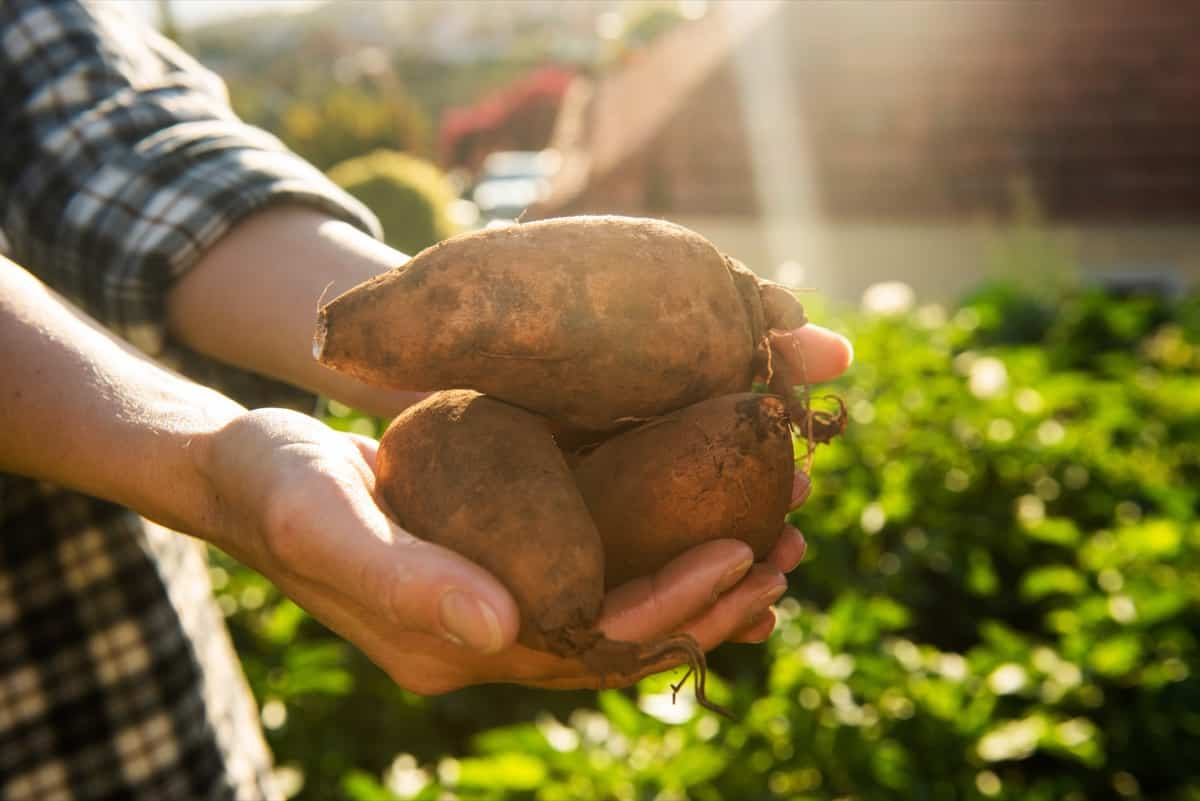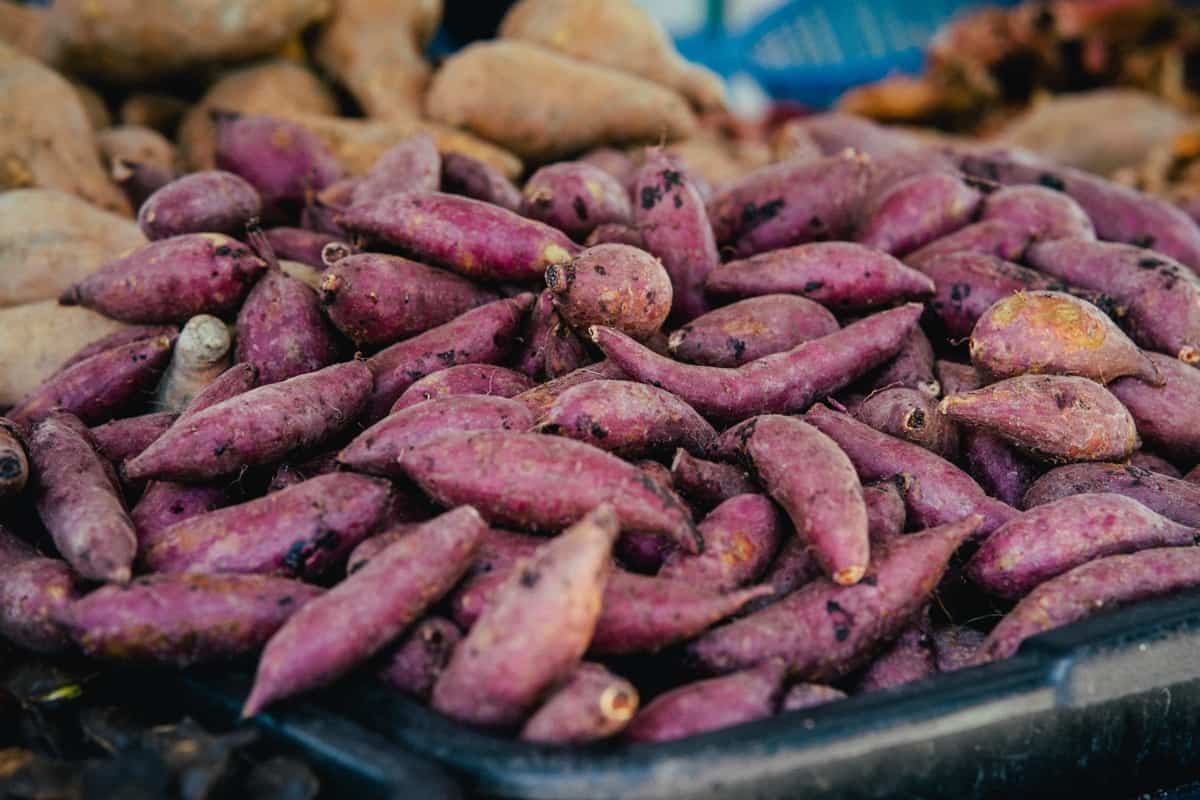Are you an aspiring sweet potato farmer looking to optimize your crop’s yield? Look no further! This comprehensive guide will explore the intricacies of managing fertilizer requirements for sweet potato crops. Fertilizer management is crucial in achieving healthy plant growth and maximizing yield.

By understanding the specific nutrient needs of sweet potatoes and adopting effective management practices, you can enhance your harvest and reap the rewards of a successful cultivation season. Sweet potato (Ipomoea batatas) is a versatile and nutritious root vegetable that belongs to the Convolvulaceae family. It is native to Central and South America and has been cultivated for thousands of years.
The sweet potato plant is a vigorous vine with heart-shaped leaves and edible tuberous roots. These roots come in various colors, including orange, purple, and white, and are rich in vitamins, minerals, and dietary fiber. Sweet potatoes are best known for their sweet taste and are consumed worldwide in various forms, such as roasted, boiled, or mashed.
Sweet Potato Fertilizer Requirements and Recommendations
Sweet Potato Nutrient Needs
- Nitrogen (N): Sweet potatoes require sufficient nitrogen for leaf and vine development. It promotes vigorous growth and increases the yield potential of the crop.
- Phosphorus (P): Phosphorus is vital for root development and plant growth. It aids in forming healthy tubers, enhancing their size and quality.
- Potassium (K): Potassium is crucial for sweet potatoes, as it helps regulate water movement and improves their resistance to diseases and pests. It also enhances the storage and taste quality of the harvested tubers.
- Micronutrients: Sweet potatoes also require various micronutrients like iron, zinc, manganese, and boron. These micronutrients are vital in enzyme activation, chlorophyll synthesis, and overall plant health.
Nitrogen Fertilization for Sweet Potatoes
Nitrogen is an essential nutrient for sweet potato crops, as it promotes vigorous growth and enhances tuber development. Adequate nitrogen fertilization is crucial for achieving optimal yields when it comes to nitrogen fertilizers for sweet potatoes.
- Nitrate-based fertilizers: These fertilizers, such as calcium nitrate or potassium nitrate, are rich in readily available nitrogen. They are quickly absorbed by the plant roots, providing an immediate nutrient boost.
- Urea-based fertilizers: Urea is a commonly used nitrogen fertilizer due to its high nitrogen content. It must be converted into ammonium by soil microbes before plants can take it up. Application timing is important to ensure optimal nitrogen availability.
- Organic fertilizers: Organic options like compost, manure, or blood meal provide a slow-release nitrogen source. They enhance soil health, promote microbial activity, and improve nutrient retention over the long term.
Phosphorus Requirements for Sweet Potatoes
Sweet potatoes require phosphorus primarily during their initial growth stages. It aids in root development, flowering, and the formation of tubers. Soil testing is essential to determine the specific phosphorus levels in your field. Based on the test results, phosphorus fertilizers can be applied to meet the crop’s demands.
One of the best phosphorus fertilizers for sweet potatoes is rock phosphate. It is a natural source of phosphorus and provides a slow-release supply to the plants. Another option is superphosphate, which contains a higher phosphorus concentration and is readily available to the crops. To ensure proper application, following the fertilizer manufacturer’s guidelines and adjusting the dosage based on soil conditions is recommended.
Incorporating organic matter and maintaining balanced soil pH levels contribute to optimal phosphorus utilization. Providing the right amount of phosphorus through appropriate fertilization practices will help sweet potatoes thrive, leading to healthy plants, abundant harvests, and a successful farming season.
In case you missed it: Growing Organic Sweet Potatoes – Planting, Farming, Tips, Ideas

Potassium Fertilization in Sweet Potato Cultivation
- Sweet potato cultivation requires adequate potassium (K) fertilization to ensure optimal growth and yield. Potassium is another essential nutrient that plays a crucial role in various physiological processes of the sweet potato plant. It contributes to root development, disease resistance, water and nutrient uptake, and plant vigor.
- To determine the potassium needs of your sweet potato crop, soil testing is recommended. A soil analysis will provide valuable insights into the potassium levels and help you make informed decisions regarding fertilizer application.
- Several options are available when selecting the best potassium fertilizers for sweet potatoes. Potassium sulfate (K2SO4) and potassium chloride (KCl) are commonly used fertilizers. Potassium sulfate is ideal for soils with low sulfur levels, while potassium chloride is suitable for soils with adequate sulfur content.
- Another effective potassium fertilizer option is potassium nitrate (KNO3). This fertilizer supplies potassium and provides a source of nitrogen, which can support balanced growth.
Micronutrient Requirements for Sweet Potatoes
Micronutrients help in plant metabolism, enzyme activation, and overall plant health. Sweet potatoes, like other crops, require specific micronutrients in varying amounts. Let’s dive into the key micronutrients needed by sweet potatoes and their functions:
- Iron (Fe): Essential for chlorophyll synthesis and enzyme activity, iron aids photosynthesis and energy production.
- Manganese (Mn): Required for enzyme activation, manganese facilitates the breakdown of carbohydrates and the synthesis of proteins.
- Zinc (Zn): Critical for hormone regulation and enzyme activity, zinc enhances root development, flowering, and fruit set.
- Copper (Cu): Vital for electron transport and enzyme reactions, copper promotes lignin production and strengthens plant cell walls.
- Boron (B): Indispensable for pollen formation and seed development, boron contributes to carbohydrate metabolism and proper cell division.
The best Micronuteiennts fertilizers for Sweet Potato Crops are Iron chelates, which are effective in correcting iron deficiencies and maintaining healthy foliage. Manganese sulfate is Ideal for preventing and treating manganese deficiencies, enhancing overall plant growth. Zinc chelates adequate zinc supply to sweet potatoes, promoting root development and yield. Copper sulfate Helps overcome copper deficiencies, enhancing plant vigor and disease resistance. Borax A reliable source of boron, essential for optimal flowering, fruiting, and tuber development.
Organic Fertilizers for Sweet Potatoes
Organic fertilizers are a sustainable, safe, and environmentally friendly option for sweet potato farmers. These natural fertilizers provide essential nutrients, promote soil health, and minimize environmental impact. Some top organic fertilizers include compost, manure, fish emulsion, bone meal, and seaweed extract. Compost improves soil structure, enhances nutrient availability, and fosters beneficial microbial activity.
Manure provides nitrogen, phosphorus, potassium, and other micronutrients. Fish emulsion stimulates plant growth and provides a balanced array of macro and micronutrients. Bone meal from crushed animal bones promotes strong root development and plant vigor. Seaweed extract enhances sweet potato plants’ stress tolerance, nutrient uptake, and disease resistance. To optimize results, follow recommended application rates and consider soil nutrient analysis.
In case you missed it: Maximizing Yields and Profit from Sweet Lime Sustainably: A Comprehensive Guide

Timing of Fertilizer Application for Sweet Potatoes
Fertilizing sweet potato crops is essential for optimal growth and yield. The best timing for fertilizer application ensures nutrients are available when they need them most. Key considerations include pre-planting, side-dressing, mid-season application, and avoiding late-season applications. Pre-planting ensures a balanced soil environment, while side-dressing provides additional nutrients during active growth. Mid-season application sustains plant growth and development, especially during tuber formation. Avoid late-season applications, as they may stimulate excessive vine growth and divert energy from tuber development.
Fertilizer Rates for Sweet Potato Production
- Nitrogen (N): Apply 60-80 kg/ha of nitrogen before planting for initial growth. Additional 40-60 kg/ha nitrogen applications can be made during the growing season at specific stages, such as vine development and tuber initiation.
- Phosphorus (P): Before planting, incorporate 60-80 kg/ha of phosphorus into the soil. This nutrient is vital for root development and tuber formation.
- Potassium (K): Apply 40-70 kg/ha of potassium before planting to promote overall plant vigor, disease resistance, and tuber quality.
- Secondary Nutrients: Calcium (Ca), magnesium (Mg), and sulfur (S) are secondary nutrients that sweet potatoes require in smaller quantities. Incorporate these nutrients into the soil based on soil test recommendations.
- Micronutrients: Apply micronutrients, such as iron (Fe), manganese (Mn), zinc (Zn), copper (Cu), and boron (B), according to soil test results and specific crop requirements.
Fertilizer application schedules can vary depending on the region and specific sweet potato variety. However, a general guideline is to split the nitrogen applications, with the first half applied at planting and the remainder applied in 2-3 subsequent applications during the growing season.
Fertilizer Placement Techniques for Sweet Potatoes
Proper fertilizer placement is essential for maximizing nutrient uptake and promoting healthy growth in sweet potato crops. Five effective techniques include banding, broadcasting, side-dressing, hill placement, and foliar feeding. Banding involves placing fertilizer in a concentrated band near the plants, ensuring direct contact between roots and nutrients, and facilitating efficient absorption.
Broadcasting spreads fertilizers evenly over the entire field, benefiting the overall crop. Side-dressing provides a localized nutrient supply and supports continuous plant development. Hill placement targets nutrients directly to the root zone, promoting robust growth and tuber development. Foliar feeding sprays nutrient-rich solutions directly onto the leaves of sweet potato plants, providing micronutrients to alleviate deficiencies and enhance plant vigor.
Sweet Potato Response to Different Fertilizer Sources
- Organic Fertilizers: Organic sources like compost, manure, and biofertilizers enrich the soil with essential nutrients, improve soil structure, and enhance microbial activity. They promote sustainable farming practices while providing long-term benefits to sweet potato crops.
- Inorganic Fertilizers: Synthetic fertilizers, such as those containing nitrogen (N), phosphorus (P), and potassium (K), offer precise control over nutrient supply. These fertilizers provide readily available nutrients and can be adjusted based on specific crop requirements.
- Controlled-Release Fertilizers: These fertilizers release nutrients gradually over an extended period, ensuring a steady supply for sweet potato plants. They reduce nutrient leaching and minimize the risk of over-fertilization, resulting in efficient nutrient uptake and reduced environmental impact.
In case you missed it: How this Farmer Earning 8 Lakhs from 3 Acres Sweet Orange Cultivation – A Success Story of a Mosambi/Sweet Lemon Farmer

Fish emulsion, bone meal, and potassium sulfate are effective fertilizers for sweet potatoes. Fish emulsion improves soil fertility, promotes healthy root development, and supports plant growth. Bone meal, rich in phosphorus, encourages strong root growth and improves flowering and tuber formation. Potassium sulfate supports overall plant growth, disease resistance, and tuber quality.
Soil Ph Requirements for Sweet Potatoes
For successful cultivation, sweet potatoes require a slightly acidic to neutral soil pH range of 5.8 to 6.5. Maintaining this pH range is crucial for nutrient availability, root development, and overall plant health. Too acidic soil hinders nutrient uptake, while excessively alkaline soil leads to nutrient deficiencies.
Fertilizer Management Practices for Sweet Potatoes
Regular soil testing is essential for determining nutrient levels and adjusting fertilizer application. Use a balanced fertilizer with an NPK ratio appropriate for sweet potatoes, incorporate organic matter, and use slow-release fertilizers for a steady supply. Apply fertilizer before planting or during early growth stages to ensure plants need them most.
Apply fertilizer in a band alongside sweet potato rows to target root development and tuber formation. Use foliar feeds to address deficiencies quickly. Water the crop adequately, mulch to conserve moisture, control weeds, and maintain a stable temperature. Practice crop rotation to reduce nutrient imbalances and minimize disease and pest buildup.
Fertilizer Interactions with Other Cultural Practices for Sweet Potatoes
Understanding the interactions between fertilizers and cultural practices is crucial for optimizing sweet potato cultivation. Factors like irrigation, weed control, and planting density influence fertilizer interactions. Proper timing and application methods are essential, such as applying fertilizers before planting, incorporating organic matter, managing weed competition, and providing adequate water supply.
Foliar Fertilization in Sweet Potato Production
Farmers are increasingly using foliar fertilization to increase sweet potato yield and quality. This method involves applying nutrients directly to the leaves, allowing quick absorption and utilization. Four effective foliar sprays are recommended for optimal results: Calcium Nitrate, Potassium Nitrate, Magnesium Sulfate, and Micronutrient Mixtures.
In case you missed it: Fertilizer Management in Potatoes: Organic, Compost Manure, NPK, and Schedule

These foliar sprays enhance nutrient uptake efficiency, rapid response, and targeted delivery. When applied correctly, foliar sprays can address nutrient deficiencies, improve plant vigor, and boost overall crop performance. Following recommended application rates, timing, and environmental conditions is essential when using foliar sprays.
Nutrient Deficiency Symptoms in Sweet Potatoes
Nutrient deficiencies can significantly impact sweet potato growth and productivity. Nitrogen deficiency leads to stunted growth, pale or yellowing leaves, and reduced tuber production. Phosphorus deficiency causes slow growth, purplish leaves, and limited root development. Potassium deficiency causes yellowing leaf margins, weak stems, and decreased yield. Calcium deficiency causes poor root development, leaf tip dieback, and internal corking of tubers.
Magnesium deficiency causes interveinal chlorosis, iron deficiency causes yellowing between leaf veins, manganese deficiency causes chlorosis and necrosis on young leaves, and zinc deficiency causes small leaves, shortened internodes, and malformed tubers. Identifying these symptoms early can prevent nutrient deficiencies from negatively impacting sweet potato crops. Regular soil testing and visual inspections can guide targeted fertilizer applications to address specific deficiencies.
In case you missed it: Grand Nain (G9) Banana Farming in India: A Cultivation Guide to Planting to Harvesting

Conclusion
Understanding and meeting the fertilizer requirements of sweet potato crops is essential for achieving maximum yield. By implementing effective management practices and addressing nutrient deficiencies promptly, farmers can optimize plant growth, enhance harvests, and reap the rewards of a successful cultivation season.
- Types of Pesticides Used in Agriculture: A Beginner’s Guide
- Economical Aquaculture: A Guide to Low-Budget Fish Farming
- 15 Common Planting Errors That Can Doom Your Fruit Trees
- How to Make Houseplants Bushy: Effective Tips and Ideas
- Innovative Strategies for Boosting Coconut Pollination and Yield
- Pollination Strategies for Maximum Pumpkin Yield
- The Complete Guide to Chicken Fattening: Strategies for Maximum Growth
- Natural Solutions for Tulip Problems: 100% Effective Remedies for Leaf and Bulb-Related Issues
- Revolutionizing Citrus Preservation: Towards a Healthier, Greener Future
- Natural Solutions for Peony Leaf and Flower Problems: 100% Effective Remedies
- Maximizing Profits with Avocado Contract Farming in India: A Comprehensive Guide
- Natural Solutions for Hydrangea Problems: 100% Effective Remedies for Leaf and Flowers
- The Ultimate Guide to Choosing the Perfect Foliage Friend: Bringing Life Indoors
- From Sunlight to Sustainability: 15 Ways to Use Solar Technology in Agriculture
- The Ultimate Guide to Dong Tao Chicken: Exploring from History to Raising
- The Eco-Friendly Makeover: How to Convert Your Unused Swimming Pool into a Fish Pond
- Mastering the Art of Delaware Chicken Farming: Essentials for Healthy Backyard Flocks
- 20 Best Homemade Fertilizers for Money Plant: DIY Recipes and Application Methods
- How to Craft a Comprehensive Free-Range Chicken Farming Business Plan
- Brighten Your Flock: Raising Easter Egger Chickens for Beauty and Bounty
- How to Optimize Your Poultry Egg Farm Business Plan with These Strategies
- Subsidy for Spirulina Cultivation: How Indian Government Schemes Encouraging Spirulina Farmers
- Ultimate Guide to Raising Dominique Chickens: Breeding, Feeding, Egg-Production, and Care
- Mastering the Art of Raising Jersey Giant Chickens: Care, Feeding, and More
- Ultimate Guide to Raising Legbar Chickens: Breeding, Farming Practices, Diet, Egg-Production
- How to Raise Welsummer Chickens: A Comprehensive Guide for Beginners
- How to Protect Indoor Plants in Winter: A Comprehensive Guide
- Ultimate Guide to Grow Bag Gardening: Tips, Tricks, and Planting Ideas for Urban Gardeners
- Guide to Lotus Cultivation: How to Propagate, Plant, Grow, Care, Cost, and Profit
- Agriculture Drone Subsidy Scheme: Government Kisan Subsidy, License, and How to Apply Online
- Ultimate Guide to Raising Araucana Chickens: Breed Profile, Farming Economics, Diet, and Care
- Bringing Hydroponics to Classroom: Importance, Benefits of Learning for School Students
- Ultimate Guide to Raising Polish Chickens: Breed Profile, Farming Economics, Diet, and Care
- Ultimate Guide to Raising Australorp Chickens: Profile, Farming Economics, Egg Production, Diet, and Care
- Silkie Chicken Farming: Raising Practices, Varieties, Egg Production, Diet, and Care
- Sussex Chicken Farming: Raising Practices, Varieties, Egg Production, Diet and Care